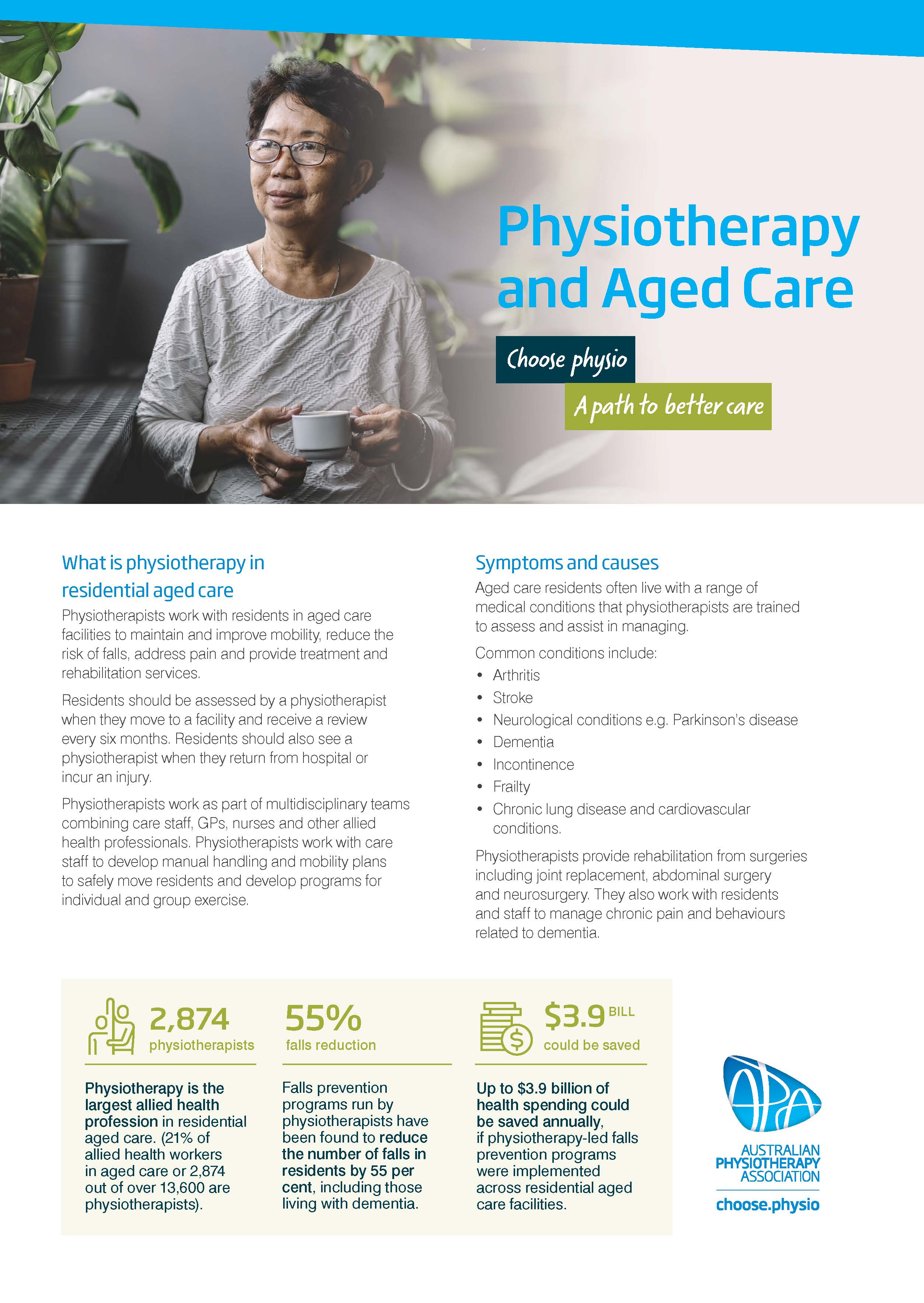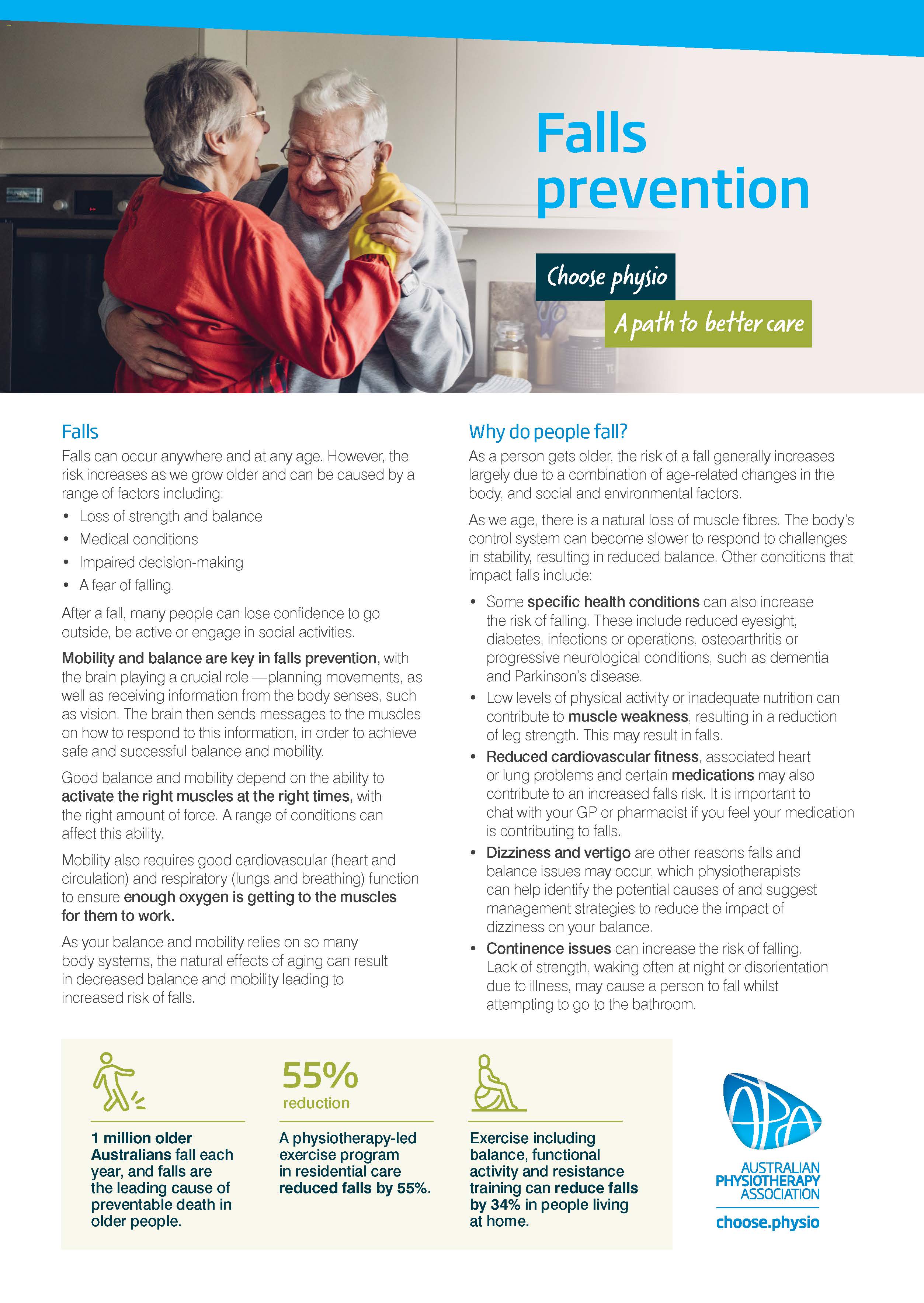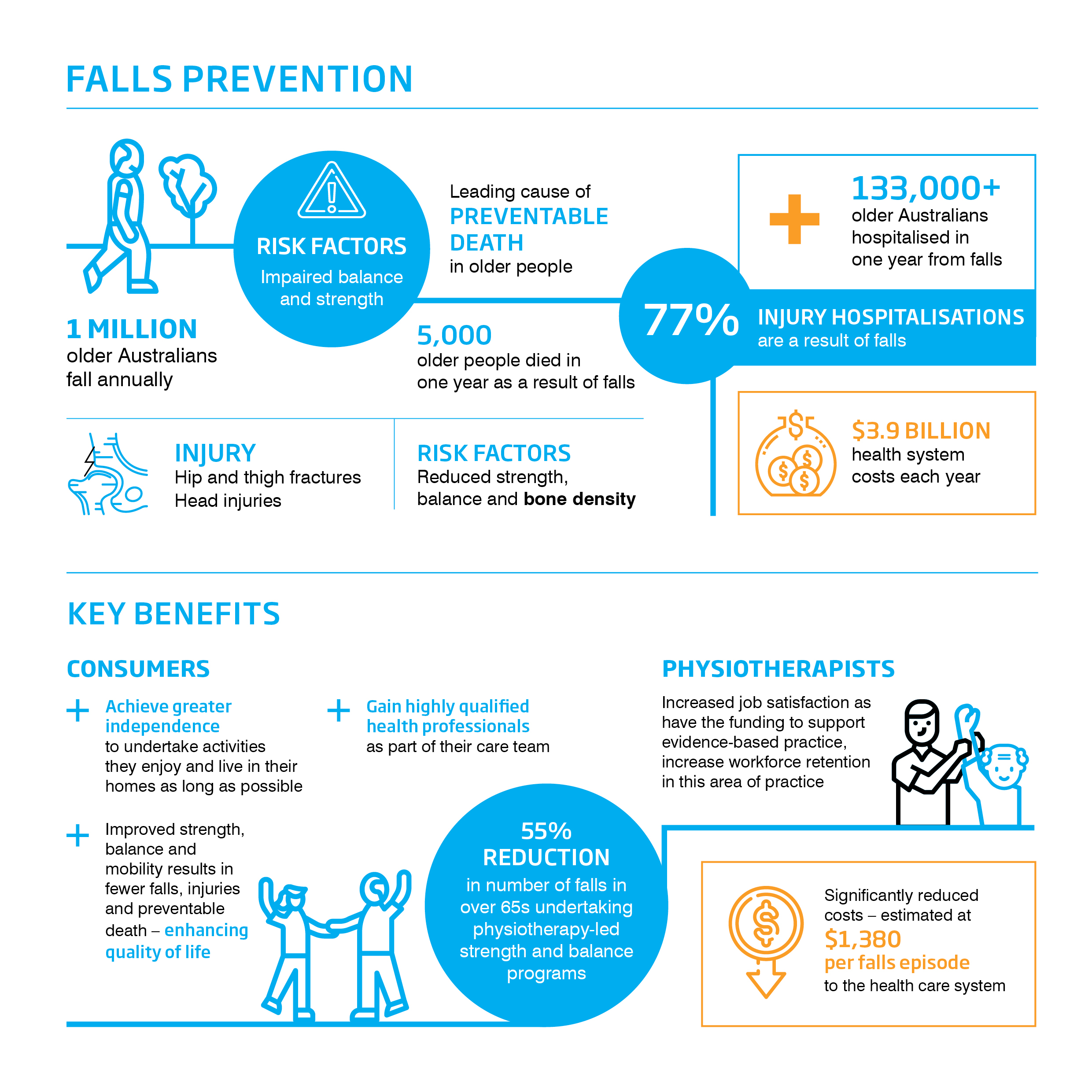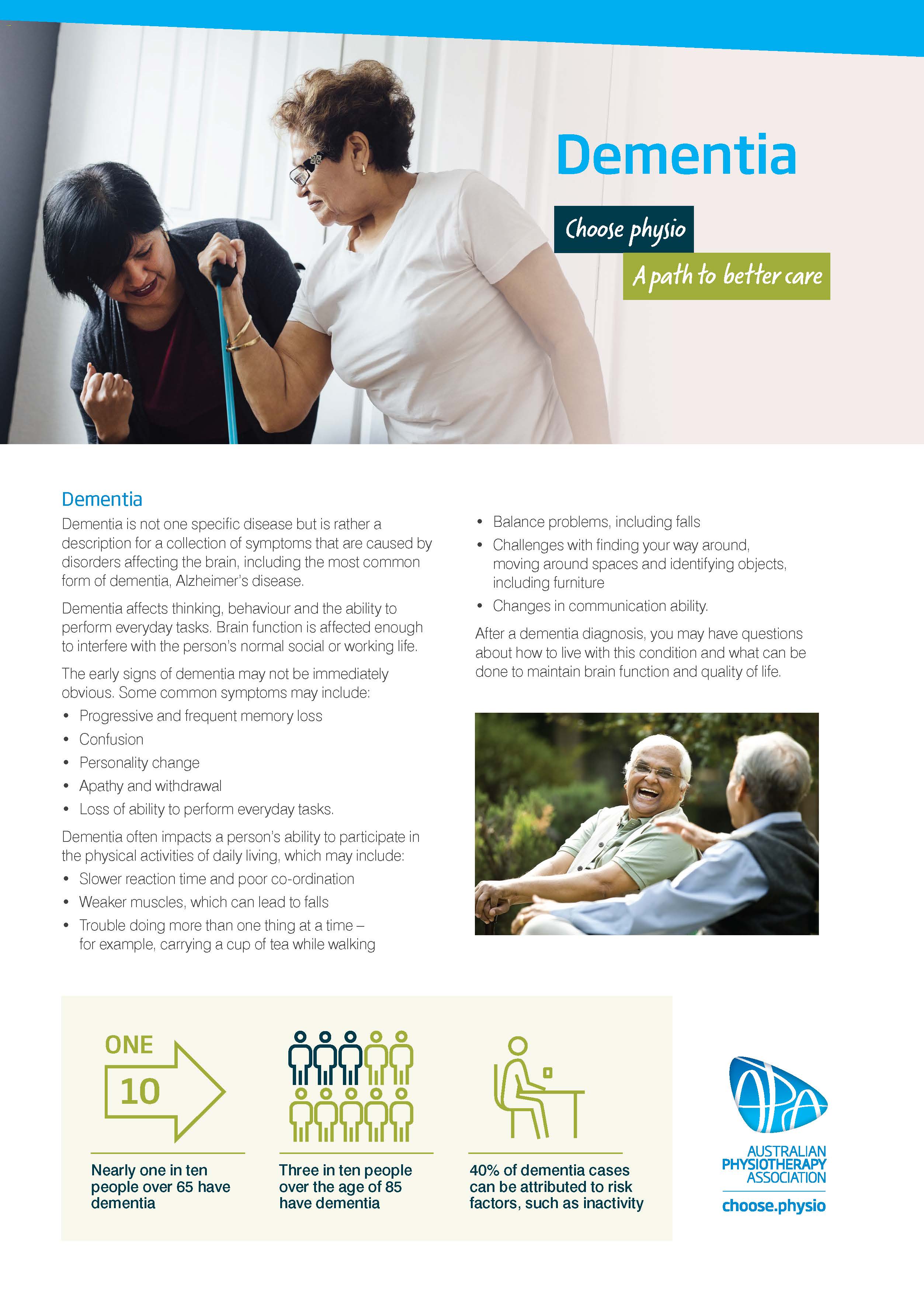There are more physiotherapists working in residential aged care than any other allied health profession. Twenty one percent, or 2,874 of over 13,600 allied health workers in aged care, are physiotherapists.
Physiotherapists work with residents to maintain and improve mobility, reduce the risk of falls, address pain and provide treatment and rehabilitation services.
Falls prevention programs run by physiotherapists have been found to reduce the number of falls in aged care residents by 55%, including those living with dementia.

--Spotlight on Aged care
Physiotherapists work as part of multidisciplinary teams combining care staff, GPs, nurses and other allied health professionals. Physiotherapists work with care staff to develop manual handling and mobility plans to safely move residents and develop programs for individual and group exercise.
An Easy English pdf has been created. This resources breakdowns physiotherapy in residential aged care in an easy to understand format.
Click the image to download the factsheet.
--Spotlight on Incontinence
Incontinence is the sudden and unplanned loss of urine or faeces. It is more common in women than in men, and occurs for more people as they age.
There are serious risks of not treating incontinence. As well as affecting quality of life, mental health and social activities, older people with incontinence have a higher risk of falls, fractures, depression, skin breakdown and infection. Incontinence is one of the main reasons for older people moving into residential aged care.
Click the image to download the factsheet.
--Spotlight on Falls prevention
As a person gets older, the risk of a fall generally increases largely due to a combination of age-related changes in the body, and social and environmental factors. As we age, there is a natural loss of muscle fibres. The body’s control system can become slower to respond to challenges in stability, resulting in reduced balance.
Click the image to download the factsheet.
Click the image to view the infographic
References to the infographic:
- INJURY: Sherrington, C., Fairhall NJ, Wallbank GK, et al. (2019). Exercise for preventing falls in older people living in the community. The Cochrane Database of Systematic Reviews, Issue 1.
- Leading cause: Australian Institute of Health and Welfare (2021), Injury in Australia, Falls
- Premature deaths of nursing home residents: an epidemiological analysis Joseph E lbrahim1. Lyndal Bu~eja , Melissa Willoughby1, Marde Bevan1. Chebiwot Kipsaina1. Carmel Young1, Tony Pham1. David L Ranson
- Improved strength and balance: Robertson, et al. (2002). Preventing Injuries in Older People by Preventing Falls: A Meta-Analysis of Individual-Level Data. JAGS, 50:905–911.
- 133,000+ hospitalisations, 5,000 deaths, 77%: Australian Institute of Health and Welfare (2022) Falls in older Australians 2019–20: hospitalisations and deaths among people aged 65 and Over
- $3.9 billion: AIHW. Trends in hospitalised injury, Australia 2007–08 to 2016–17. Canberra: Australian Institute of Health and Welfare;2019
- $1,380: The Value of Physiotherapy in Australia, Nous Group, 2020
- 55%: Hewitt J, Goodall S, Clemson L, Henwood T, Refshauge K. Progressive Resistance and Balance Training for Falls Prevention in Long-Term Residential Aged Care: A Cluster Randomized Trial of the Sunbeam Program. J Am Med Dir Assoc. 2018 Apr;19(4):361-369. doi: 10.1016/j.jamda.2017.12.014. PMID: 29402651.
--Spotlight on Dementia
Dementia is not one specific disease but is rather a description for a collection of symptoms that are caused by disorders affecting the brain, including the most common form of dementia, Alzheimer’s disease.
Click the image to download the factsheet.
--Why we need physiotherapy in aged care?
A physiotherapist can help you or your loved one living in aged care, in a number of ways, every day. Physiotherapists take the time to talk to residents and understand their goals, enabling and assisting them to stay on their feet where possible, during both exercise and everyday activities.
Residents should be assessed by a physiotherapist when they move into a facility and receive a review every six months. Residents should also see a physiotherapist when they return from hospital or incur an injury.
Physiotherapists also work with care staff to develop manual handling plans to safely move residents.
When a new resident moves to an aged care facility, a physiotherapist would tailor a mobility care plan that enables staff to safely support that residents’ movements.
If a resident has had a fall, a physiotherapist would assess the resident for injury, plan to reduce the risk of further falls, review mobility and offer relevant treatment.
Physiotherapists develop exercise programs for individual residents and for group activities that help to improve or maintain faculties, such as balance.
Physiotherapists provide rehabilitation from surgeries including joint replacement, abdominal surgery and neurosurgery and work with residents and staff to manage chronic pain and behaviours related to dementia.
--Common conditions experienced by residents in aged care
Aged care residents often live with a range of medical conditions that physiotherapists are trained to assess and assist in managing.
Common conditions include:
- Arthritis
- Stroke
- Neurological conditions e.g. Parkinson’s Disease
- Dementia
- Incontinence
- Frailty
- Chronic lung disease and cardiovascular conditions.
--What restrictions are preventing greater access and funding?
Residents of aged care facilities have less access to primary care services, including Medicare-funded physiotherapy, than those living in the community.
Physiotherapists working in residential aged care have historically been funded through the Aged Care Funding Instrument, which limits the treatment that physiotherapists can provide to only massage and the use of TENS machines. This is due to specific funding definitions surrounding the tool.
Physiotherapists have adapted to offer these specified treatments, as well as manual therapy, exercise and pain education - treatments that enable longer-lasting and more effective pain management for many residents.
Up to $3.9 billion of health spending could be saved annually, if physiotherapy-led falls prevention programs were implemented across residential aged care facilities.
For quality, informed care, physiotherapists should be in regular attendance at facilities, so they can be familiar with residents’ medical history, personality and usual level of function.





